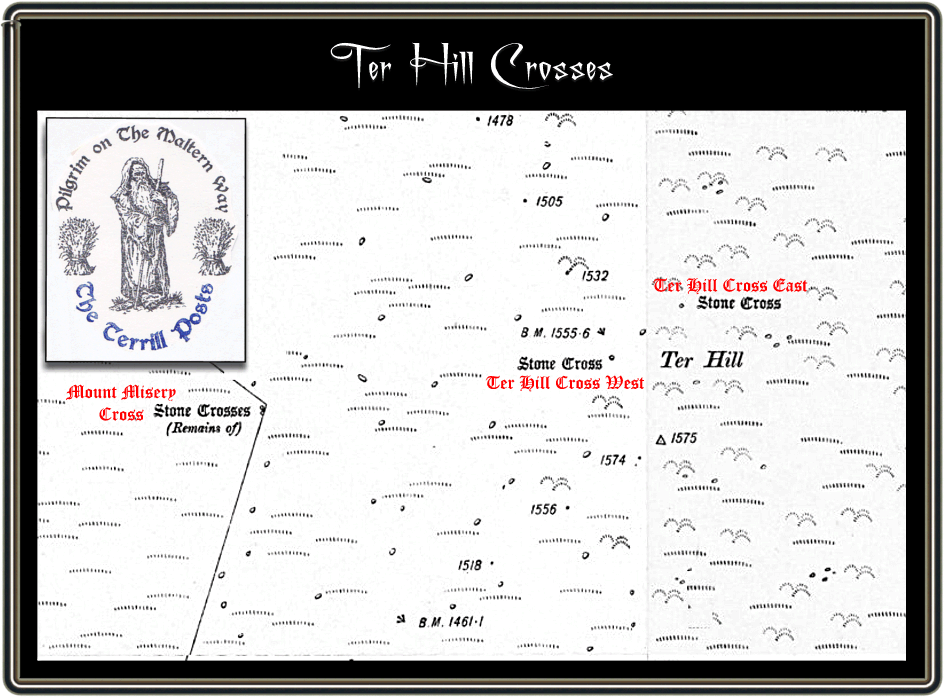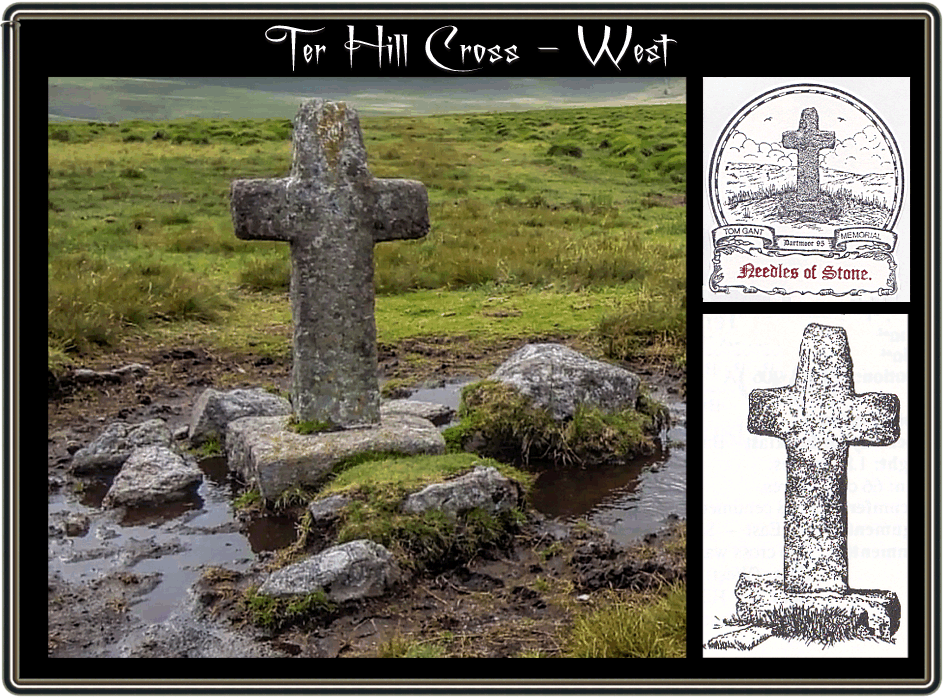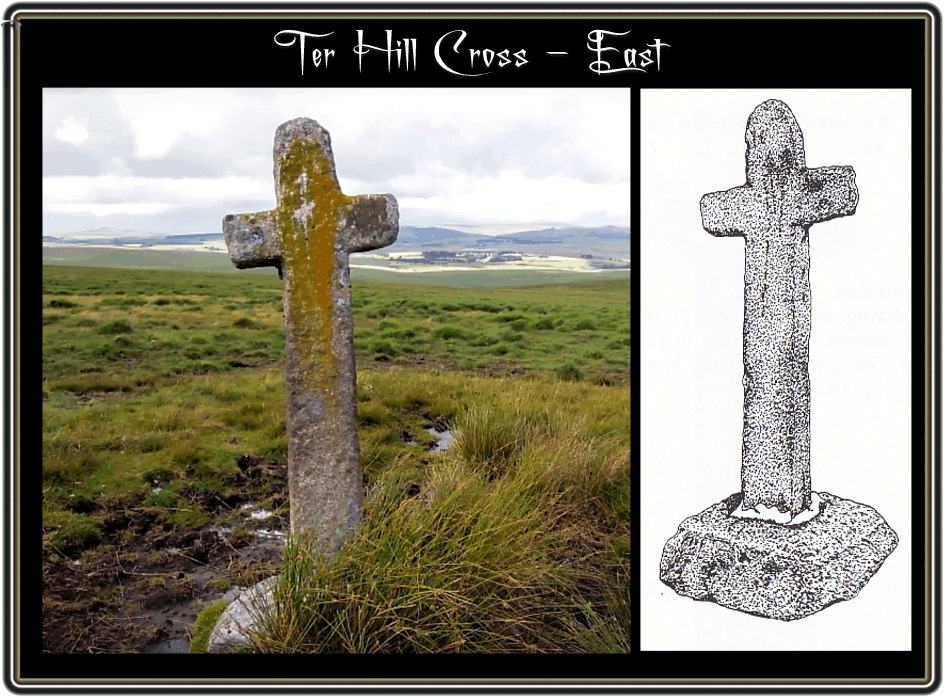
Sitting on top of Ter Hill are two granite crosses (known locally as the ‘Terhill Posts‘) which at onetime marked the old monastic track which ran between the abbeys of Tavistock to Buckfast. They are part of a line of 12 other such crosses which acted as guideposts for those travelling the desolate moors. There is a possibility that this age old track was also known as ‘The Maltern Way‘ and was used by folk transporting barley seeds and other byproducts. Apart from the many hidden secrets these old crosses can tell they can also relate the harsh vagaries they have suffered at the hand of man and beast.
I will let William Crossing introduce the first of the crosses in question, namely the westernmost of the pair; “We now ascend the slope in front of us, still pursuing an easterly direction, and shall soon reach a grassy track, not very plainly marked, except for a short distance, but yet discernible in its course through the heather. Ere we have proceeded far we shall come across a cross lying by the side of the path, the shaft of which has been broken, but is now repaired.” p.97, this would be the westerly of the two crosses known as the ‘Terhill Posts‘. In 1885 the sorry state of this cross was brought to the Dartmoor Preservation Association who along with other moor crosses initiated a programme of re-erection and repair. Unfortunately it appears that the repairs were none to effective due to the fact that a portion of the shaft was missing. The result being that one metal bar was fixed vertically thus joining the two remaining halves together with another horizontally to hold one of the broken arms in place. Additionally the spot where the cross was re-erected was slightly west of its original location in what at the time was the firmest ground. Sadly not long after its restoration this arm was once more broken off by livestock using it as a rubbing post. For the next 100 years or so the cross fell over several more times, some as a result of itchy livestock and at least once at the hands of some vandals. In the August of 1925 the following letter appeared in the Western Times;
“During the week ending August 1 some visitors to the moor uprooted and threw over an ancient cross on the top of Terhill, in a lonely part of the moor. This cross was erected hundreds of years ago by the monks as a guide to sound ground and safe way between Tavistock and Buckfast, and in modern times and for many years has in foggy or misty weather been of great service as a genuine guide or beacon to stockmen and others crossing the dreary waste. It must have taken two or three men with tools a considerable time and much labour to do this job, as is evident by the marks on the ground and on the socket stone. Visitors often leave gates open and carelessly start fires in the heather, little thinking of the loss and trouble they cause, but it is rarely that for no apparent reason they do so much a wicked, mischievous, and senseless piece of vandalism.
Once again the cross was restored, this time by the efforts of Lt. Goldsmith who was also responsible for discovering and re-erecting another of the crosses further down the Maltern Way (known as Goldsmith’s Cross). Once again these repairs were none too effective and in 1982 the cross was found to have fallen over again with the result that it had snapped in two. Repairs with steel dowels were carried out but these too were none too effective against the onslaught of Dartmoor’s weather and livestock. So finally after a great deal of discussion and consultation the Dartmoor National Park Authority decided enough was enough and removed the cross from Ter Hill completely. By 1994 the cross was once again restored but it was decided that there seemed little sense in putting the cross back onto Ter Hill only to be damaged again. Their solution was to relocate the cross to the ‘Jack Wigmore Memorial Garden’ which is located at the back of the Princetown High Moors Visitor Centre where it could rest in peace. However this left a huge gap in the line of crosses so it was decided to make a replica of the cross and locate it where the original once stood. It was also decided at the time that the replica cross would also act as a memorial to Tom Gant who was a well known Dartmoor author, guide and enthusiast. It was on the 21st of June 1994 that the new cross was placed in the garden. In addition a small metal plaque was placed on a rock near to the replica cross on Ter Hill which reads; “The Ancient Cross here, Was replaced in 1994, In memory of, Tom Gant, Who loved Dartmoor.” The funds for the entire project were raised by the friends of Tom Gant hence the fitting memorial. It is worth noting that the early iron bars used to restore the original cross were not included in the replica version. The replica cross and therefore presumably the original cross stand at a height of 1.21 metres with an arm span of 69 centimetres along with a shaft circumference of 89.5 centimetres. Sandles, p.102.
The second of the ‘Terhill Posts’ lies just over 100 metres to the north-east of its neighbour and in comparison seems to have had a much less turbulent history. However, this Latin style cross has also had to endure an early indignity of damage and relocation. Again I will let William Crossing introduce it; “Directing our steps to the other cross, we shall find it to be a very fine one, and in a complete state, with the exception of a slight injury to the shaft, a small piece having been broken off one of the corners.“, p.98. He also relates how at sometime in the mid to late 1800s the cross was removed to the courtyard of nearby Sherberton by its owner, Mr. Coaker, probably for aesthetic reasons? However, the Duchy of Cornwall came to learn of its transplantation and insisted that it be restored to its original location. This demand was halfheartedly met as yes it was taken back to its home but never erected and simply left lying recumbent. On the 8th of August of 1885 the Dartmoor Preservation Association stepped in and re-erected the cross. On that morning the Honorary Secretary of the Dartmoor Preservation Association met with William Crossing along with some workmen. The party made their way to Ter Hill where their first task was to deepen the socket hole, then cement was used to fix the socket stone in place and the cross re-erected into it, Crossing p.98. Today the cross stands at a proud height of 1.80 metres tall and has an arm span of 66 centimetres, the circumference of the shaft is 88 centimetres, Sandles, p.104. If you ever visit this cross on a fine day then it is possible to see Skir Ford cross, this being the previous cross in the line of 12 and naturally the cross’s neighbour. It is also interesting to see that both of the ‘Terhill Posts’ have their arms pointing along the direction of the old trackway which begs an interesting question, was this the original intention of those who first erected the crosses? Just like the signposts of today which point the direction of travel, were they meant to do the same? There is however one problem with this and that is the crosses would be more visible in the landscape if the arms were pointing across the track as opposed to being side on?
Finally one small aside to the Ter Hill crosses, there was back in the 1980s another cross to be found on the hill although I would imagine by now it’s long gone. It was a very small cross simply made from two long nails and was located amongst the rocks near the hill’s summit. Nobody knows who put it there or why but it certainly featured amongst several letterbox clues.

Crossing, W. 1987. The Stone Crosses of Dartmoor and its Borderland. Exeter: Devon Books.
Sandles, T. 1997. A Pilgrimage to Dartmoor’s Crosses. Liverton: Forest Publishing.
 Legendary Dartmoor The many aspects past and present of Dartmoor
Legendary Dartmoor The many aspects past and present of Dartmoor



